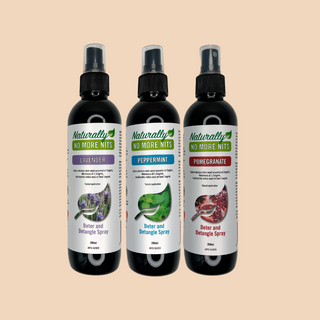To deter head lice, you can follow several preventive measures. While these methods cannot guarantee complete prevention, they can help reduce the risk of infestation and the severity of infestation. Here are some steps you can take:
- Avoid head-to-head contact: Head lice are usually transmitted through direct head-to-head contact with an infested person. Encourage children to avoid activities that involve close contact with other people's heads, such as sharing hats, combs, or headphones.
- Educate children and adults: Teach children and adults about the importance of not sharing personal items that come into contact with the head, including combs, brushes, hair accessories, and helmets.
- Regularly check for lice: Conduct regular checks of your child's scalp, especially if there has been a reported lice outbreak at school or within the community. Look for live lice or their eggs (nits) attached to the hair shafts close to the scalp. Early detection can help prevent the spread.
- Tie back long hair: Keeping long hair tied up or in braids can make it more difficult for lice to transfer from one person to another.
- Use lice repellent products: There are various lice repellent products available on the market, such as leave in conditioners and deter sprays. Naturally No More Nits Deter Sprays are Australian Made, Vegan and Organic and contain nothing artificial. These products contain ingredients like tea tree oil, neem oil, or essential oils that may help deter lice. Follow the instructions provided by the manufacturer when using these products – using these products on damp hair will make the product go further and you will use less of these products.
- Launder bedding and clothing: Regularly wash and dry infested bedding, clothing, and personal item. This can help kill any lice or eggs that may be present. Put any hair accessories, combs, brushes into a zip lock bag and in the freezer. Air bedding for at least 24-36 hours as head lice can not survive off the hed longer than this.
- Vacuum and clean the environment: Vacuum upholstered furniture, rugs, and car seats to remove any potential lice or fallen hairs with attached nits.
Remember, if you or your child does become infested with head lice, there are effective treatments available which are gentle and insecticide free.
It's essential to follow the instructions provided by the product or consult an expert such as Tangled Hair Care for guidance.
It is important to remember that not everyone experiences itchiness with lice. I have seen many infestations where the client has not noticed any itch or hints that they have lice.
We recommend a weekly check of all family members for lice and eggs to keep the house nit free
To check for lice, you can follow these steps:
- Look for symptoms: Check for common signs of lice infestation, such as persistent itching of the scalp, the feeling of something moving in the hair, small red bumps or sores on the scalp or neck, and the presence of nits (lice eggs) or adult lice in the hair.
- Use good lighting: Find a well-lit area, preferably natural daylight or a bright lamp, to examine the hair.
- Section the hair: Divide the hair into small sections to make the inspection easier. You can use hair clips or ties to keep the sections separate.
- Start at the scalp: Begin examining the hair close to the scalp, as lice prefer to lay their eggs there. Look for live lice moving around or nits attached to the hair shafts. Nits are tiny, oval-shaped eggs that are usually yellow or white in color and are firmly attached to the hair.
- Check behind the ears and neckline: Lice and nits are commonly found in these areas, so pay close attention to them during your inspection.
- Use a fine-toothed comb: A lice comb can be helpful in detecting lice and nits. Comb through each section of the hair from the scalp to the ends, wiping the comb on a tissue or paper towel after each stroke. Examine the material on the tissue for any lice or nits.
- Repeat the process: Continue inspecting the entire head, section by section, until you have checked all areas of the scalp.
It's important to note that lice can be challenging to spot, especially if the infestation is in the early stages. If you're unsure or suspect an infestation but can't find any definitive evidence, it's advisable to consult an expert such as Tangled Hair Care for a thorough diagnosis.

